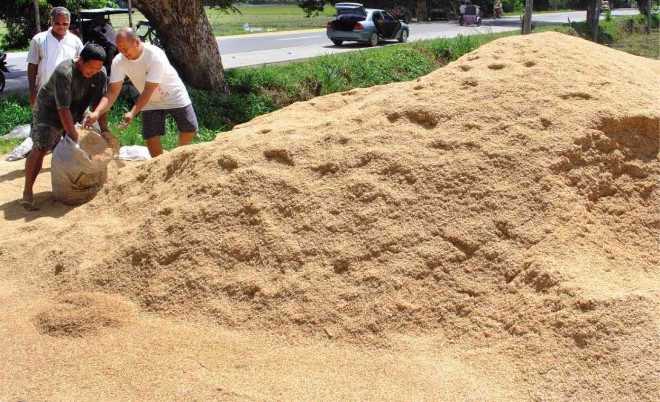Even prices of rice hull rising

BURLY men bag rice hull from a heap near the national highway in the Science City of Muñoz. Formerly regarded as an unwanted byproduct in palay milling, rice hull, also called “ipa,” has become a pricey commodity, their buying price now as much as P1 a kilogram. Anselmo Roque/Inquirer Central Luzon
SCIENCE CITY OF MUÑOZ, Philippines— Once regarded as an unwanted byproduct of palay, rice hull, known here as “ipa,” is now an expensive commodity in farming areas in Nueva Ecija province.
In the past, rice millers considered the disposal of ipa one of their major problems.
Records from agriculture research agencies here said that of the 14 million metric tons of palay milled in the country each year, at least 3.1 million MT become ipa.
Agriculture experts said big millers had devoted several hectares of their lands to the dumping ground of ipa. Others without land to spare dumped it elsewhere, including roadsides where these were burned or washed off by rainwater toward irrigation canals, creeks or rivers.
Edgardo Alfonso, president of the San Jose City Rice Millers Association, said ipa had become expensive because cement manufacturers now used rice hull in their products.
Article continues after this advertisementHe said ipa, which is also used as fuel for rice hull-powered electric plants, now sells for 80 centavos to P1 a kilogram.
Article continues after this advertisementAlfonso, also chief operating officer of San Jose City I Power Corp., said his company would soon buy rice hull at P1 per kg from the 26 rice millers in San Jose once their power plant starts operating in the last quarter of this year.
“We will be using 100,000 MT to 120,000 MT of rice hull for our plant every year. It is about 70 percent of the volume produced in our city yearly,” he said.
Alfonso said his company was planning to put up another power plant and would buy the rest of the rice hull spewed out by the mills in San Jose City and its neighboring towns.
Another power plant, which will generate 12 megawatts of electricity, is being built in Talavera town. The plant would use rice hull produced by a big rice mill based in that town, reports said.
But farmers who operate a government-distributed flatbed- drying facility are complaining about the scarcity of supply and the high cost of rice hull that power the facility’s machine.
“I buy rice hull now for P2,000 [if loaded on an Isuzu Elf truck] or P5,000 [if loaded on a 10-wheel truck],” said Willy Bernardo, who operates a drying facility in the Science City of Muñoz.
“At times, I have to wait for days [to get rice hull] because the millers sell it to cement factories,” he said.
Also affected by the value increase of rice hull are people engaged in the production of carbonized rice hull (CRH). Promoted by the Philippine Rice Research Institute (PhilRice) here, CRH, or partially burned rice hull, is used as substrate, or a surface on which an organism grows or is attached, to organic fertilizer, soil conditioner, water purifier, filter or absorbent, charcoal or odor neutralizer.
PhilRice said the Organic Farmers Unit Association in Pangasinan province was the first to cash in on the production of CRH by exporting it to Japan.
Five other people’s organizations, it said, also made money for the production of CRH in collaboration with PhilRice, the Philippine Rural Reconstruction Movement and a company engaged in exporting CRH. Anselmo Roque, Inquirer Central Luzon